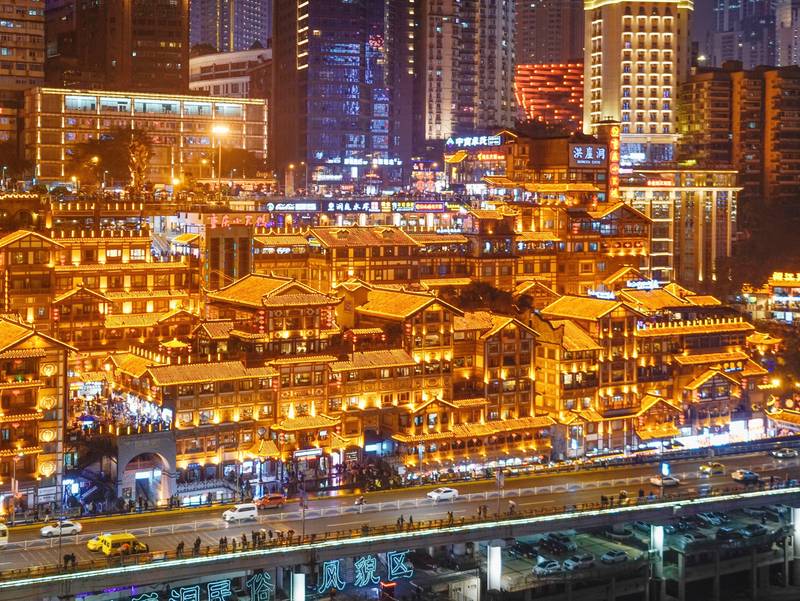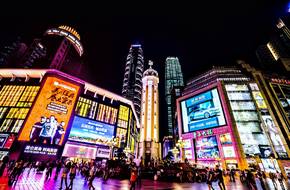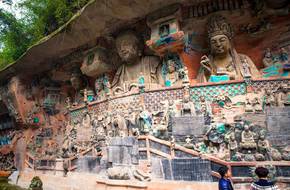Geographical Location
Nestled in southwestern China, Chongqing is a city defined by its dramatic topography. Surrounded by the Wu and Daba mountain ranges, it sits at the confluence of the Yangtze and Jialing Rivers, creating a landscape of steep hills, deep valleys, and winding waterways. Often called the “Mountain City” (山城), about 78.7% of its area is covered by mountains and hills, making it one of China’s most vertically striking metropolises. The city’s subtropical climate brings misty mornings, hot summers, and mild winters, adding to its mysterious allure.
Transportation
Getting around Chongqing is an adventure in itself. The city’s metro system connects major attractions like Hongya Cave and Ciqikou Ancient Town, with signs in English and clear announcements. For a unique experience, take the Yangtze River Cableway (长江索道), a gondola ride offering panoramic views of the city skyline and river. The Light Rail Line 2 is famous for passing through a residential building at Liziba Station—a jaw-dropping sight you’ll want to capture! Taxis and ride-sharing apps like Didi are widely available, though navigating the city’s maze-like streets can be tricky. Pro tip: Use a 3D map app to account for the hilly terrain!
Natural Landscapes
Chongqing’s natural beauty is as diverse as its cuisine.
- Wulong Karst National Park: A UNESCO World Heritage site, this area features Tiankeng Three Bridges (天生三桥), massive natural stone arches carved by erosion, and the Longshuixia Ground缝, a narrow canyon with cascading waterfalls.
- Jinfo Mountain: A year-round destination, it offers skiing in winter and hiking trails through ancient forests in spring and summer. Don’t miss the Gaoshan Azalea Garden, where rare flowers bloom in May.
- Yangtze River Three Gorges: A 193-km stretch of breathtaking gorges, best explored by cruise ship. The Qutang Gorge is particularly iconic, with sheer cliffs rising from the river.
Cultural and Historical Sites
Chongqing’s history and culture are deeply intertwined with its geography.
- Hongya Cave: A riverside complex of stilted buildings (吊脚楼) inspired by ancient Bashu architecture. At night, it’s illuminated like a fairytale castle, overlooking the Jialing River.
- Ciqikou Ancient Town: A preserved Ming Dynasty village filled with teahouses, craft shops, and street food stalls. Try mao tofu (fermented tofu) or chongqing xiao mian (spicy noodles).
- Dazu Rock Carvings: A UNESCO site featuring 50,000 Buddhist, Taoist, and Confucian statues carved into cliffs. The Ten-Thousand-Buddha Cliff is a masterpiece of precision and symbolism.
- Chongqing Three Gorges Museum: Learn about the region’s history, from ancient cultures to the construction of the Three Gorges Dam.
Food and Dining
Chongqing’s cuisine is world-famous for its spicy hotpot (火锅), a communal meal where you boil meats, veggies, and tofu in a numbing chili broth. Must-try dishes include:
- Lamp Shadow Beef (灯影牛肉): Thin, spicy beef slices named for their transparency when held to light.
- Chongqing Noodles (小面): Wavy wheat noodles tossed in chili oil, peanuts, and sesame paste.
- Zongzi: Sticky rice dumplings filled with pork or red bean, wrapped in bamboo leaves.
Head to Nanbin Road for upscale dining with river views, or explore Liberation Stele Pedestrian Street for street food stalls.
Modern Attractions
Chongqing seamlessly blends old and new.
- Liberation Stele (解放碑): The city’s symbolic landmark, surrounded by skyscrapers, luxury malls, and neon-lit streets.
- Chongqing Grand Theatre: A futuristic building hosting opera, ballet, and traditional Sichuan opera performances.
- Chaotianmen Square: At the tip of the Yuzhong Peninsula, it offers stunning views of the Yangtze and Jialing Rivers merging.
Travel Tips
- Language: While English signage is improving, learning a few Chinese phrases (e.g., xiè xie for “thank you”) can be helpful.
- Weather: Summers are scorching—pack light clothing and sunscreen. Winters are mild but misty.
- Safety: The city is generally safe, but watch your belongings in crowded areas.
- Currency: Cash is still widely used, especially in markets and small restaurants.
Nearby Destinations
Extend your trip to these nearby gems:
- Chengdu: Just 1.5 hours by high-speed train, visit the Giant Panda Research Base and explore ancient temples.
- Jiuzhaigou Valley: A 9-hour drive or 1-hour flight away, this UNESCO site features turquoise lakes, waterfalls, and snow-capped mountains.
- Wulong: Perfect for hiking and exploring the Furong Cave, a massive limestone cave with stunning stalactites.




